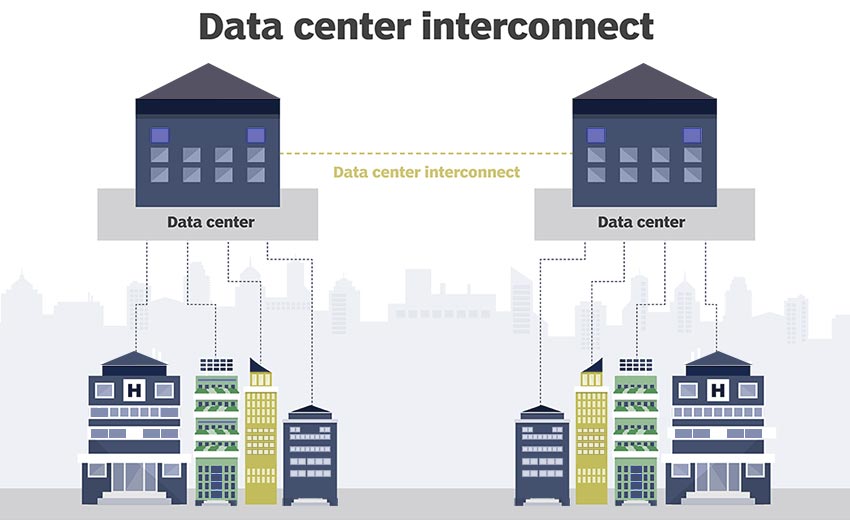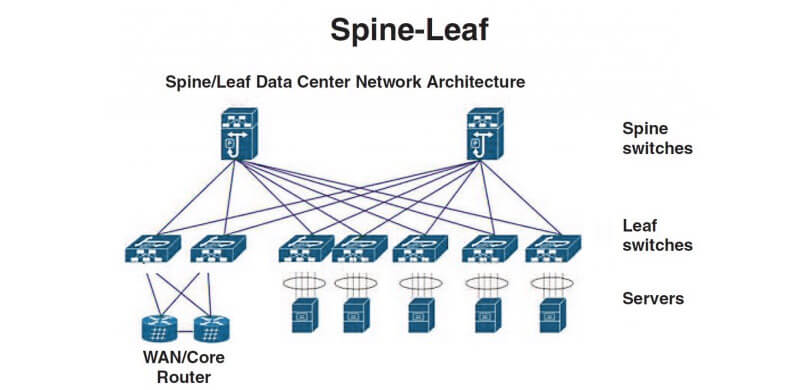Transceivers in data center interconnect
What is Data Center Interconnect?
As can be seen from the word, DCI refers to the network connection of two or more data centers. However, there are various ways of this connection. Depending on the distance and transmission capacity, engineer can use a variety of different technologies for interconnection, which is a broad concept. DCI can be built from the optical layer, using switches and routers. DCI generally refers to the interconnection of different data centers of operators, or the interconnection of enterprise-level data centers. In 2022, the demand for cloud services will explode, and the capacity, cost of data center interconnection will become several key points. Optical modules play a linking role in data centers, and we will introduce them in detail.

DCI Data center essentials
Distance
The distance of the DCI application depends on the dispersion of each data center. When they are in the same city, a link of tens of kilometers is often enough to interconnect them. If you are in two countries, or even two continental plates, this means a distance of hundreds of thousands of kilometers. The distance factor greatly affects the choice of the DCI scheme. For metropolitan area network links within 80km, sometimes there is no need to choose a high-cost coherent optical module solution, and the conventional 100G DWDM optical module solution can meet the performance requirements.
Capacity
In recent years, bandwidth requirements have exploded, and enterprise routers have been upgraded from 100Gb to 200Gb or even 400Gb. Coherent optical modules may be the only option to meet such high bandwidth requirements. It can achieve a rate of 800Gpbs on a single wavelength and expand the available spectrum from the C-band to the L-band. This allows more wavelengths to be utilized, increasing the capacity of the DCI. But the cost is also greatly increased.
Cost
To improve efficiency, data flows in data centers must be transported as cost-effectively as possible, so reducing the cost per Gbps of interconnects is a central issue. In the construction cost of the data center, the procurement cost of the optical module is the key point. Optical modules are involved in any layer of data center hardware, from the SFP+ DAC at the bottom to the 400G QSFP-DD at the top. In order to reduce the cost of optical modules while providing sufficient capacity, you should try to choose high-quality and inexpensive brands, such as third-party optical module suppliers. This will reduce the cost of purchasing optical modules by more than 60%.
Role of Optic Transceiver modules in Data Center layout
Optical modules are used within and between data centers. Optical transceivers are used in data centers to transmit and receive optical or electrical signals.

For the inside of the data center, in the common leaf-spine architecture of the data center, 50G/40G optical modules are often used as a bridge from the access layer equipment to the aggregation layer equipment, and 100G/200G optical modules are often used from the aggregation layer to the core layer. The closer to the top of the architecture, the greater the data transfer capacity.
For the interconnection of small data centers in the medium and short distances, the cost of renting optical cables is inexpensive and the transmission capacity is not very large. We can apply 100G LR/ER modules or 400G-LR8 QSFP-DD modules.

In the long-distance large-capacity transmission, the connection between data centers often adopts DCI equipment based on the DWDM system. This type of device can provide OEO function and port aggregation function, and multiple 10G/40G/100 GbE client ports can be mapped to DWDM wavelength coherent optical modules with 200G, 400G and even 800G. The characteristics of the coherent optical module are that the dispersion tolerance is extremely high, the transmission within 2000KM does not need to consider the dispersion problem, and the band is tunable, and it can easily transmit hundreds of kilometers with EDFA, which is very suitable for metropolitan area network applications.
The higher the transmission rate, the longer the distance, and the higher the cost for optical modules. Therefore, to reduce the cost, we should select the optical module according to the needs such as data rate or distance, otherwise the cost will be significantly increased.
Development of Optical Modules in interlink Data Center
Before 2014, the SFP-1G was often used from the access layer to the aggregation layer within the data center, while the SFP+ 10G was used from the aggregation layer to the core layer, and the connection between data centers generally used QSFP 40G/100G modules for transmission. After 2014, data transmission increased dramatically, and the transmission rate of enterprise servers increased to SFP 10Gb/25Gb, and QSFP+ 40Gbps/QSFP28 100Gpbs was used for transmission from the aggregation layer to the core layer. In 2016, the coherent module was released, and 200G CFP2 coherent modules linked the large data centers, and the DWDM system can achieve Tbps-level transmission capacity. Today, most of the core layer switches use 100G optical modules, such as QSFP28-SR4 or QSFP28-LR4. There are two transmission solutions between large data centers, one is the well-known 100G/200G/400G coherent solution, and the other is the 100G PAM4 solution. The QSFP28 100G PAM4 solution can achieve a transmission capacity of 4TB on a single-fiber link, and the transmission distance is within 80km. This also meets the interconnection needs of most data centers. At the same time, the cost of PAM4 is much lower than that of coherent modules, and this solution is very popular in Europe.
Summary
You can get all of the above optical modules for data center interconnection at QSFPTEK.com. QSFPTEK is a historical optical module manufacturer, we do not distribute transceivers but focus on producing and selling optic modules. These transceiver modules are at shocking prices. If you are curious about how QSFPTEK’s price is different compared to other third-party modules, you can read this article: SFP Module Prices Comparison by Top 5 SFP Manufacturers 2022
Besides, everyone can watch the production process of our modules on Youtube: On the Scene of QT Lab | QSFPTEK










